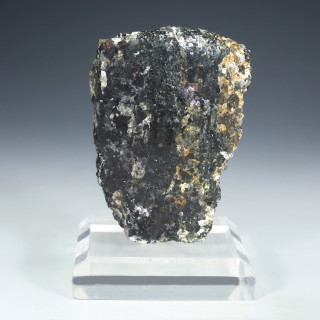Akilia Greenland Earth's Earliest Biochemistry [122 g ~ 3.85 Ga]
Brand : Sciencemall-USA
- SKU:
- JPT-92861
- Condition:
- New
- Availability:
- Usually ships in 24 hours.
- Weight:
- 1.00 LBS
- Minimum Purchase:
- 1 unit
- Maximum Purchase:
- 1 unit
- Shipping:
- Calculated at Checkout
Akilia Oldest Rock 122 g – Earth's Earliest Biochemistry
Why Akilia Rocks Change Everything
This 122-gram diamond-polished specimen from Akilia Island, West Greenland is no ordinary stone — it’s a time capsule from over 3.85 billion years ago. Inside this metamorphosed quartz–pyroxene rock are micro-scale graphite inclusions that carry the same carbon isotope signature seen in living systems today. You’re not just holding a rock — you’re holding a fragment of the world before continents, oxygen, or even stable oceans. It’s a specimen that speaks directly to the question: When did life truly begin?
The Cradle of Ancient Chemistry
The Akilia supracrustal sequence sits adjacent to the legendary Isua Belt — the earliest known exposure of Earth’s crust. Here, high-grade metamorphism transformed primordial sediments and volcanic layers into banded quartz–pyroxene rock, preserving the fingerprints of prebiotic oceans and ancient iron formation processes. These rocks formed as the planet cooled from its molten youth — a chemical cauldron where life first found its foothold.
The δ¹³C Mystery — Light Carbon, Ancient Life?
Encased within apatite crystals, graphite grains with δ¹³C ≈ –28 ‰ tell a compelling story. Such “light” carbon is the hallmark of biological carbon fixation — the same isotopic bias life exhibits today. Even after metamorphic transformation, these carbon inclusions remain sealed in place, their chemistry whispering across billions of years. Recent work shows the Akilia rock’s marine-sedimentary origin aligns with environments that could have sustained early microbial ecosystems — a powerful argument that this may represent the earliest biogenic signal on Earth.
What δ¹³C Really Means
Life prefers the lighter isotope, 12C — and that preference leaves a trace. When scientists measure δ¹³C, they’re essentially detecting life’s chemical accent in the carbon record. Values around –25 to –30 ‰ usually point to biological fractionation, whether from ancient microbes or early carbon-fixing pathways. Life prefers the lighter isotope, 12C — and that preference leaves a trace. When scientists measure δ13C, they’re essentially detecting life’s chemical accent in the carbon record, or δ13C-depleted signatures that point to biogenic carbon. Finding this signature in a rock older than 3.8 billion years is nothing short of extraordinary — it’s life’s earliest possible signature.
Deep Time, Real Science
Only a handful of rocks on Earth break the 3.8-billion-year barrier. The Akilia sequence bridges chemistry, geology, and the origin of biology itself — a tangible piece of Earth’s first experiment with living matter. This specimen invites you to study, question, and connect with the processes that shaped every living thing since.
Specimen Details
- Dimensions: 66 mm L × 48 mm W × 27 mm D
- Weight: 122 grams
- Composition: Quartz, Pyroxene, Magnetite, Garnet
- Finish: Professional diamond-polished face, natural rough back
- Imaging: Front, back, side, tag, and magnified close-ups of this exact specimen
Included with Purchase
- Certificate of Authenticity
- Scientific Tag and Stand; Information about the Specimen
- Information Sheet entitled: Akilia and Isua: Contrasting Windows into Earth’s Earliest Crust
- Not Included: plexiglass base and photo cube
Legit, Ethical, and Provenanced
This material was legally obtained through trade with a scientific institution, ensuring full ethical provenance and documentation for academic, educational, or collector use.
For Collectors Who Think in Billions, Not Millions
Akilia’s ancient graphite–apatite story is not just a scientific debate — it’s a dialogue with time itself. Add this mini museum specimen to your collection and own a genuine piece of Earth’s formative biochemistry. Available exclusively from Sciencemall-USA.
Additional Information
Akilia vs Isua — Geographic and Structural Context
Where Akilia is Located
Akilia Island lies just off the coast of southwestern Greenland, a few kilometers south of the main Isua Supracrustal Belt (ISB) exposures near Nuuk.
Shared Crustal Framework
Both localities belong to the broader Itsaq Gneiss Complex, which hosts enclaves of Eoarchean supracrustal rocks (3.7–3.9 Ga) preserved within tonalite–trondhjemite–granodiorite (TTG) gneisses.
Relationship to Isua and Akilia
-
Both Isua and Akilia are enclaves or belts of supracrustal rocks that occur within or immediately adjacent to the Itsaq Gneiss Complex.
-
Structurally, the IGC is the host terrane, and the supracrustal units (Isua, Akilia, Ameralik, etc.) are inliers preserved between TTG gneiss domes.
-
The IGC thus acts as the crustal framework tying these ancient rock bodies together.
Why Akilia is Different
Akilia is a smaller, isolated fragment that is deeply metamorphosed and migmatized—essentially a reworked remnant of an older supracrustal belt that may be stratigraphically deeper than Isua’s main preserved sections.
Metamorphic Grade and Preservation
Akilia: High-Grade, Texture-Limited
Akilia reached granulite facies (>750 °C), producing pyroxene-bearing assemblages (hence the quartz–pyroxene rock). This intense metamorphism obliterated most primary textures.
Isua: Lower Grade, Fabrics Preserved
Isua, in contrast, is amphibolite to greenschist facies—much lower grade. Original sedimentary and volcanic features (banding, pillow lavas, chemical layering) remain visible.
Geologic Relevance for Both Akilia — Isua
This difference explains why Isua preserves stromatolitic laminae and primary BIF textures, while Akilia preserves isotopic evidence—the physical sedimentary fabric is largely gone.
Field Interpretation Summary
- Isua: recognizable geology — banding, layering, stromatolitic fabrics.
- Akilia: isotopic fossil — graphite–apatite signatures in a metamorphic matrix.
Buy now, limited supply!










![Isua Greenstone Belt 23.9 gram specimen [92175] shown front on a plexiglass riser. Isua Greenstone Belt 23.9 gram specimen [92175] shown front on a plexiglass riser.](https://cdn11.bigcommerce.com/s-ijipkdz2cc/images/stencil/500x659/products/136/3393/Isua-92175-banded-iron-front__70400.1738628319.jpg?c=1)

